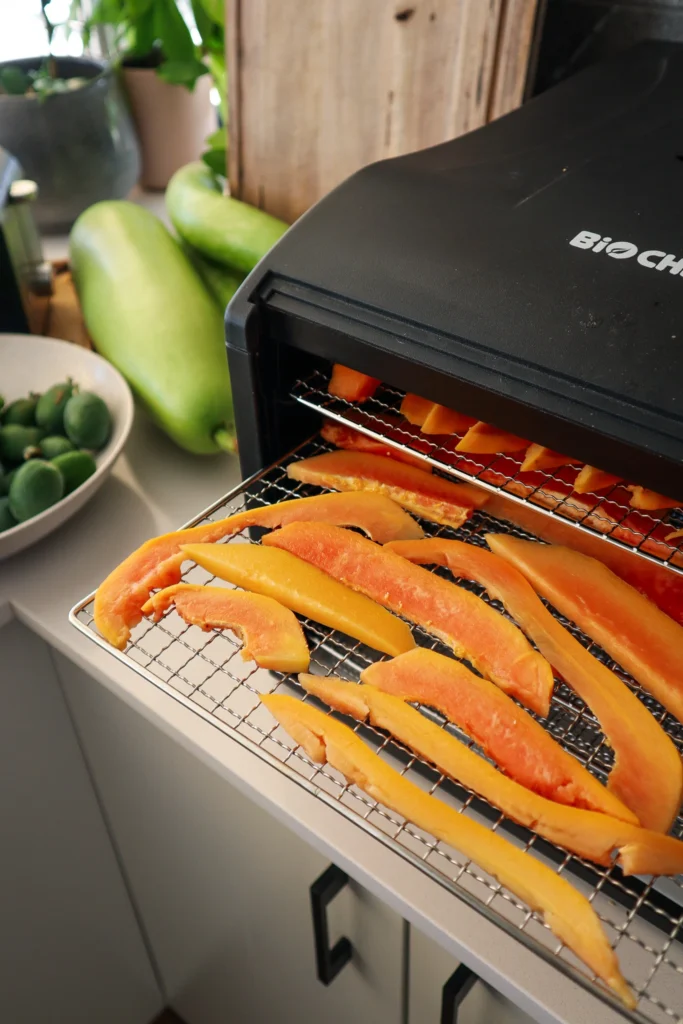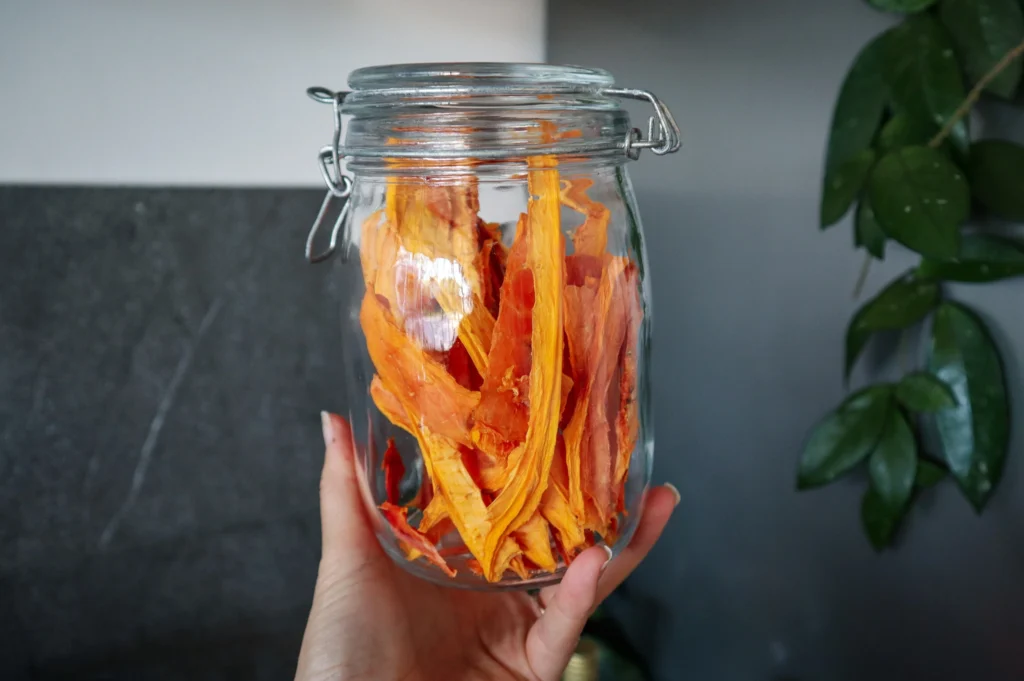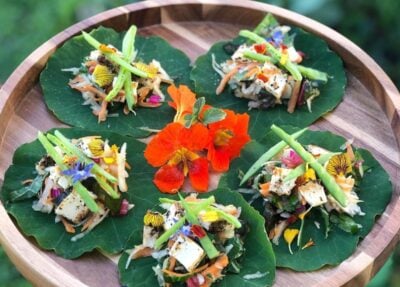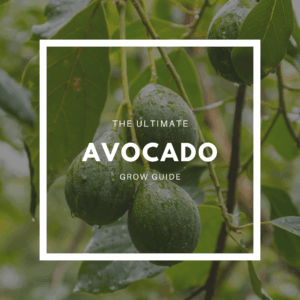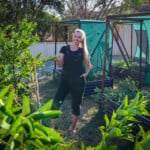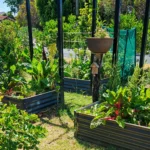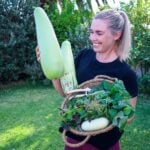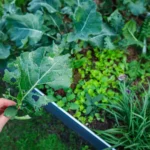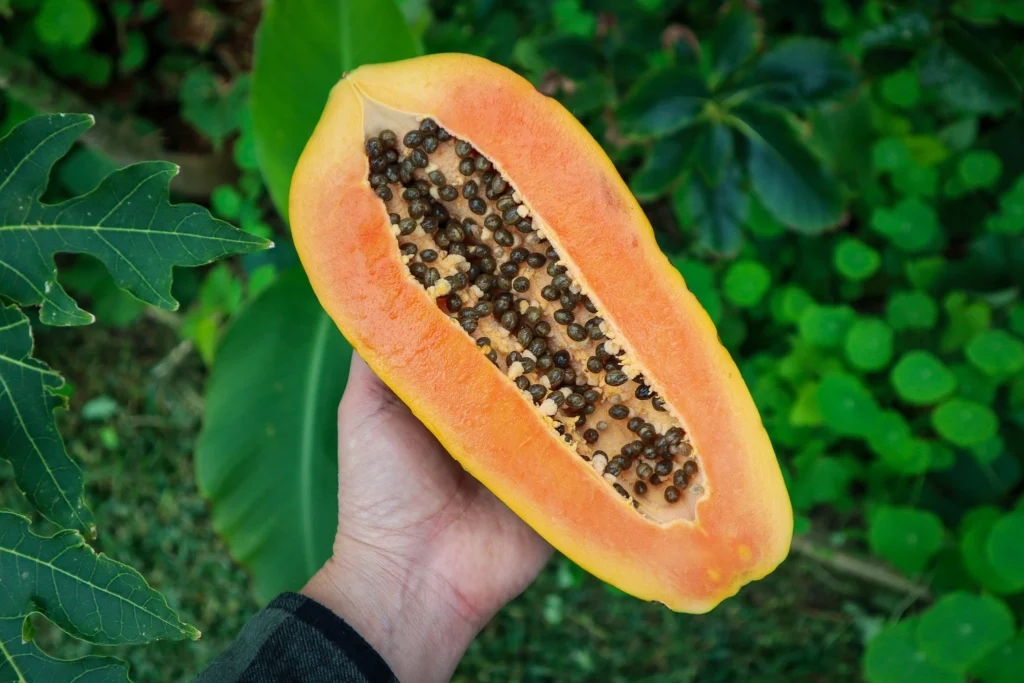
How to Grow Payaya
Learn how to grow Papaya (Carica papaya) at home from seed and what to make with your abundant Papaya crops! Papayas are a must-grow plant if you live in a warm climate and want abundant, quick harvests, vertical shade, and tropical vibes in your food forest or backyard. They grow fast, produce generous fruit, and are surprisingly easy to start from seed, making them perfect for urban permaculture gardens!
I have 6 Papaya plants that I’ve grown from seed and love how they act as an umbrella for my hot gardens, plus offer so much fruit! The amazing thing about Papaya is that you can harvest it green and use it like a vegetable, or wait for it to tree ripen and develop a sweet tropical flavour. They have quickly become one of my top picks for a low-maintenance, productive fruit tree that fits beautifully into even small gardens.
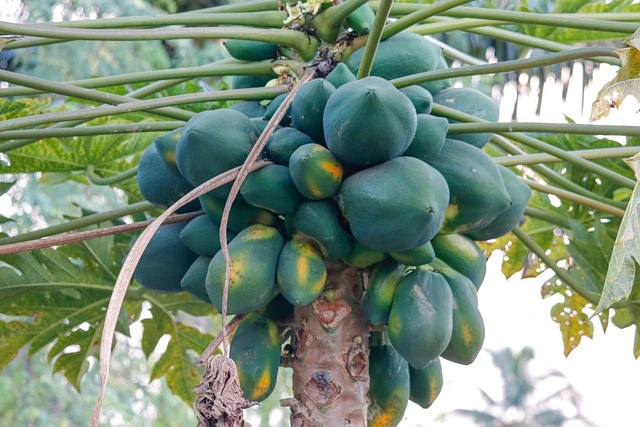
What parts of Papaya are edible?
Fruit (Ripe Papaya) – Edible
- The orange to reddish flesh of ripe papaya is sweet, soft, and full of enzymes.
- Commonly eaten fresh, in smoothies, salads, salsas, or desserts.
- High in vitamin C, A, and papain (a digestive enzyme).
Seeds – Edible (in moderation)
- Have a peppery, slightly bitter flavour—can be eaten fresh or dried and ground as a pepper substitute.
- Rich in enzymes and antimicrobial properties, but best in small amounts (they can be too potent or slightly toxic in excess).
Green (Unripe) Fruit – Edible when cooked
- Used as a vegetable in curries, stir-fries, or grated into salads (like Thai green papaya salad).
- Contains more papain, which breaks down proteins—great for tenderising meat.
- Must be cooked or prepared properly, especially for those sensitive to latex.
Flowers – Edible (especially male flowers)
- Sometimes used in traditional dishes in Asia and the Pacific Islands.
- Have a mild bitter flavor; usually sautéed or boiled before eating.
⚠️ Parts NOT Recommended to Eat Raw:
- Stem, latex, and roots: Contain milky sap (latex), which may cause irritation or be mildly toxic.
- Unripe parts (fruit or leaves) should be cooked if consumed, especially for people with latex sensitivity.
Quick Tips on How to Grow Papaya at Home
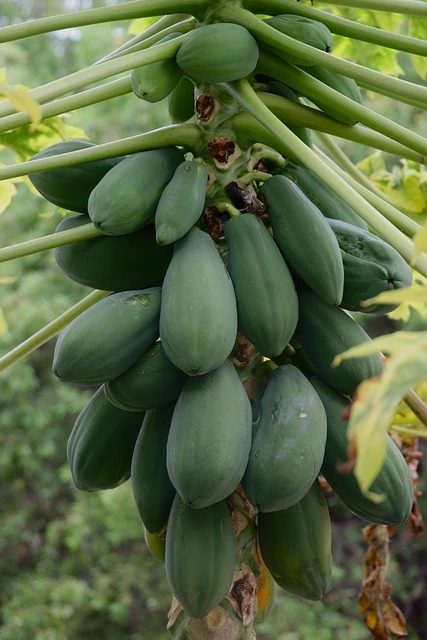
Why Grow Your Own Papaya?
Here are some of the many reasons to grow Papaya.
- Super fast-growing fruit tree
- Suitable for pots or small spaces
- Vertical growth = space saver
- Produces fruit in under a year
- Can grow tall to act as a shade umbrella
- Perfect for syntropic and food forest layering
- It can be used as a fruit or a vegetable
- Versatile uses in the kitchen
How to tell Papaya Plant Sex: Male, Female & Bisexual
Male
Mainly just produces flowers with many on long shoots. Sometimes they will produce fruit also at the end of the long stem. Males are often the quickest to start flowering. Keep one if you want to pollinate females, but usually not needed if you grow bisexual types.
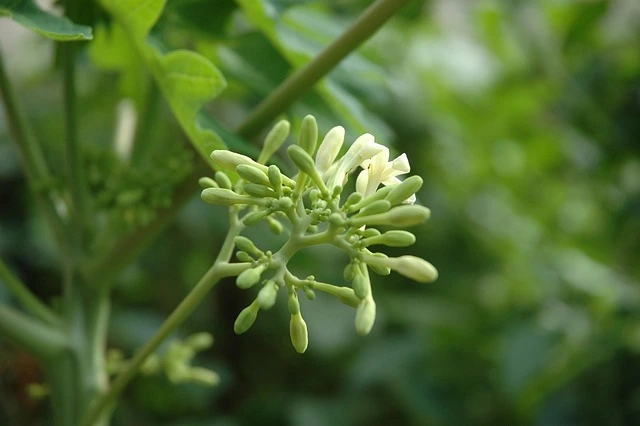
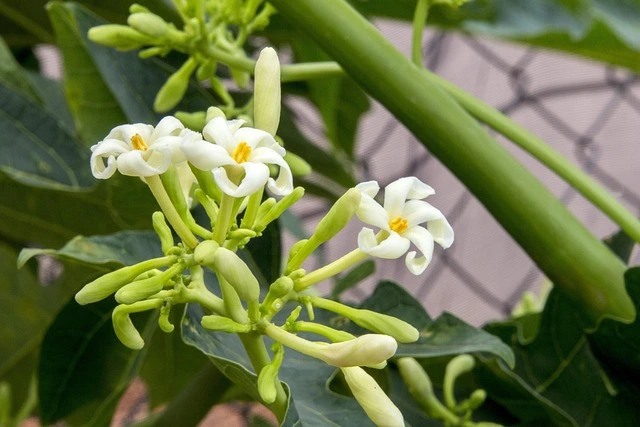
Female
Produces the largest flowers with mini Papayas tucked under their unfurling white petals. They fruit better if pollinated by a male or bisexual plant. Fruit is rounder and often larger than bisexual fruits. Female fruits sometimes have fewer seeds inside and even none when they haven’t been pollinated.
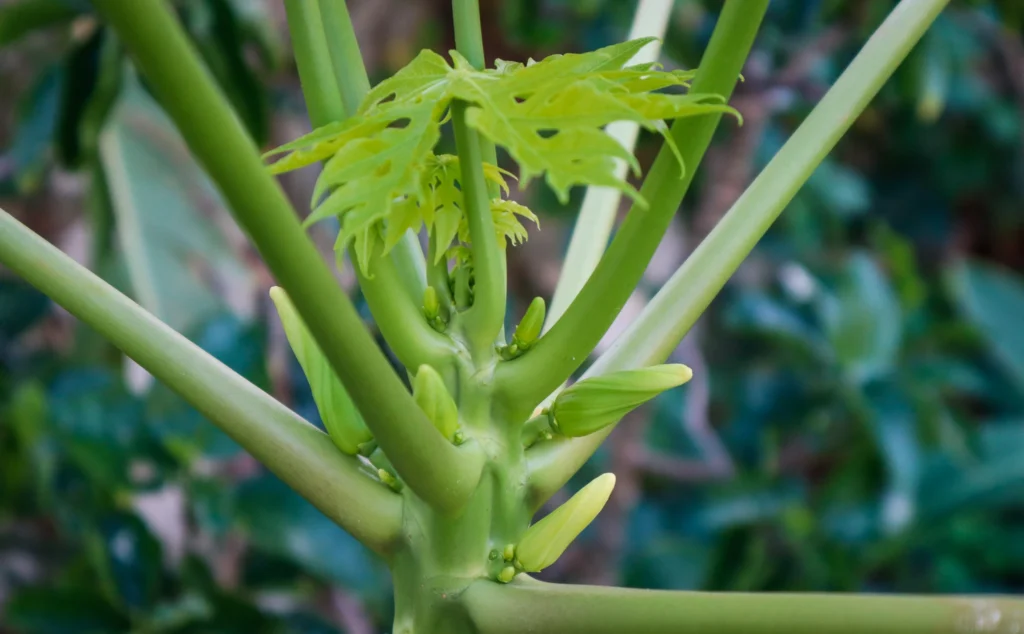
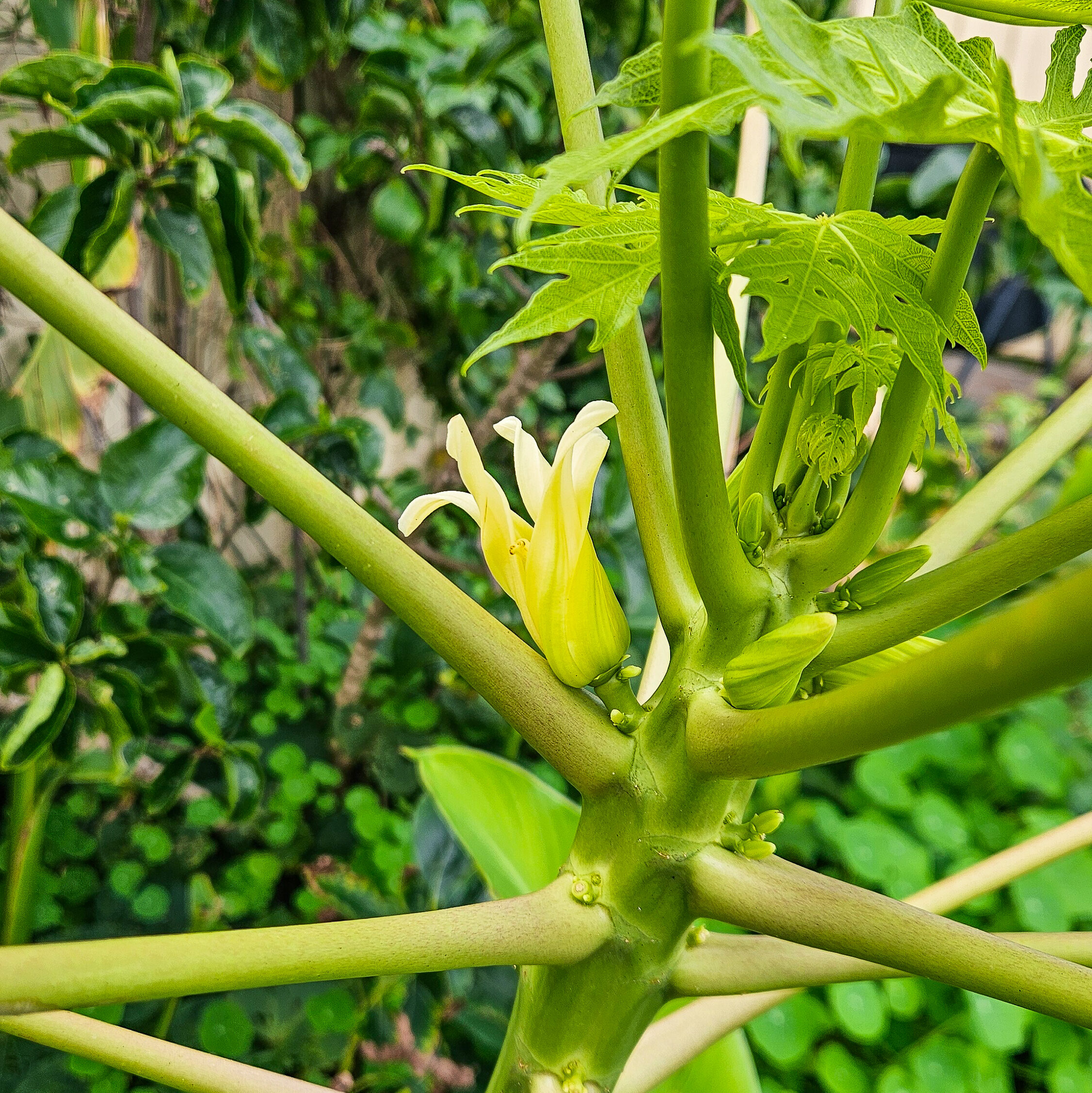
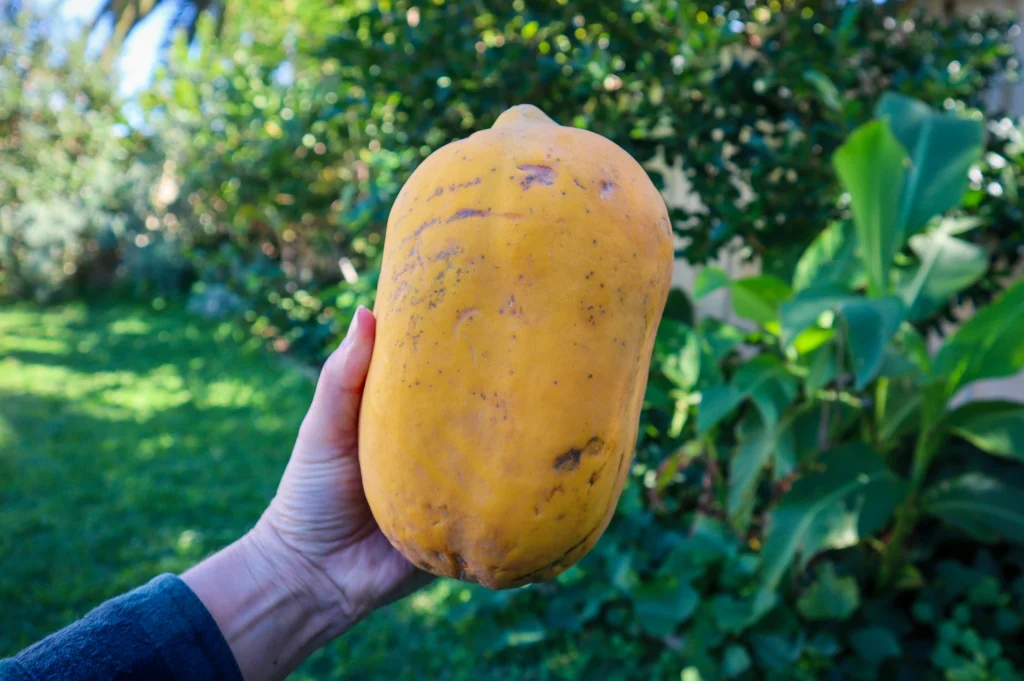
Bisexual (Hermaphrodite)
Produces small flowers in clusters close to the main stem (unlike the male, which clusters on long stems). Self-pollinating and highly productive. The fruit is usually more elongated with plenty of seeds inside. Ideal for small gardens as you only need one plant.
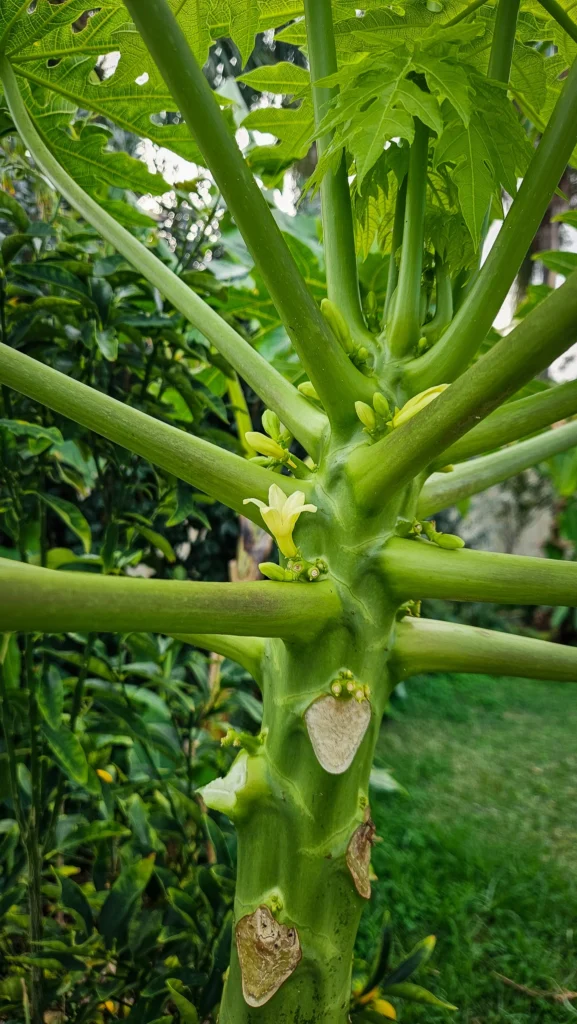

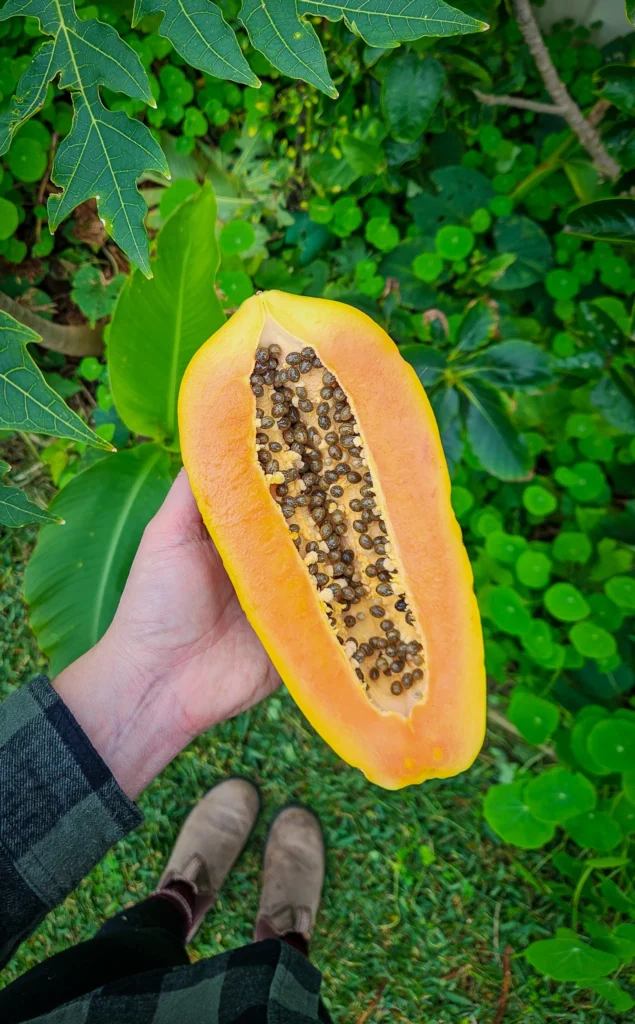
When can you tell what sex a Papaya is?
You won’t know the sex until flowers appear, usually a few months in, when the plants are about 0.5 – 1m tall. This is why it is a good idea to grow your own from seed and plant multiple seedlings (5–6) and remove males later, unless needed for pollination. Some nurseries will falsely sell Papaya plants as Bisexual, but because they are all grown from seed, there is still a chance of getting a male or female plant.
Popular Papaya Varieties
Red Army- Large, firm red-fleshed fruit with excellent flavour and good shelf life.Bred for disease resistance and improved productivity in Australian conditions.
Pink Lady – Deep pink flesh, sweet flavour, smooth texture. Performs well in warm, humid climates and responds well to regular feeding.
Southern Red – Sweet, deep red-orange flesh, medium-sized fruit. Australia’s most commonly grown red papaya variety. Productive and widely available.
Solo Sunrise – Small, sweet, pear-shaped fruit with orange-red flesh. Compact plant, good for pots or smaller gardens.


TOP TIPS TO GROW PAPAYA
- Choose a warm sunny location
- Prepare the soil with plenty of compost
- Free draining is key!
- Papayas hate wet feet and can rot easily. In clay soils – mound up above the ground rather than planting down in a hole
- Do not disturb roots when removing from the pot.
- Protect from frosts and high winds
- Keep the trunk clean and clear with good airflow.
- Remove older yellowing leaves
- Keep weed-free and well-mulched
How to Grow Papaya from Seed
You can grow papayas from shop-bought or homegrown fruit. Ideally, source locally grown fruit as supermarket-imported fruit is often treated and has fewer viable seeds. Here’s how:
Step-by-Step:
- Scoop out fresh papaya seeds and rinse off pulp.
- Gently squeeze the seed to pop the casing off and reveal the bumpy seed.
- Plant 2–3 seeds per hole in a sunny seed-raising tray or directly into a garden bed.
- Thin out to the strongest seedling once sprouted.
- Keep at least 5-6 plants, either in pots or the ground and wait until they start to flower to determine sex.
💡 Tip: Papayas don’t like transplanting or having their roots disturbed. Plant in their final position early to minimise root disturbance.
Temperature & Climate Conditions for Growing Papaya
Papayas (Carica papaya) love the heat and grow best in tropical to warm subtropical climates. They’re fast-growing but sensitive to cold, so choosing the right spot and protecting young plants is key.
Ideal Temperature Range:
- Optimal growth: 21°C to 33°C
- Minimum temperature: 10°C (below this, growth slows significantly)
- Frost-sensitive: Frost can damage or kill papaya trees, especially young ones.
If you’re in a warm coastal or inland area with mild winters (like parts of WA, QLD, NT, or northern NSW), papayas will thrive year-round. In cooler zones, they’ll need protection from cold, wind, and frost—especially during their first 1–2 years.
Tips for Growing Papaya in Cooler Zones:
- Plant in full sun, ideally with a north-facing wall, fence or thermal mass to reflect warmth
- Use a frost cloth or a mini greenhouse in winter if needed
- Grow in large pots and move under cover during cold snaps
- Apply thick mulch and avoid planting in frost-prone low spots
Want to Grow Papaya in Cooler Climates? Try These Alternatives:
If your garden gets frost or struggles to stay warm through winter, papaya might not be the easiest option. But there are a few cold-tolerant cousins and lookalikes worth trying!
Mountain Papaya (Vasconcellea pubescens)
- Native to the Andes, this papaya relative handles much cooler temps—even light frosts! This one is popular back home in New Zealand. I haven’t been able to find a plant here in Western Australia…yet.
- Grows well in temperate zones with protection.
- Fruit is smaller, ripens to yellow and is pear-shaped
- Champagne-like flavour and you can eat the seeds as well.
- Bonus: It’s often grown for its enzyme-rich latex, like papain.
Babaco (Vasconcellea × heilbornii)
- A natural hybrid related to mountain papaya.
- Alaos called the Champagne fruit due to the flavour.
- Grows in cool subtropical to mild temperate zones—tolerates down to around -2°C with protection.
- Produces seedless, tangy-sweet fruit that tastes like a mix of pineapple, pawpaw, and lemon.
- Compact, attractive tree perfect for pots or small backyards.
- Needs pruning to keep productive, and doesn’t tolerate root disturbance.
North American Pawpaw (Asimina triloba)
- Not related to papaya, but often confused due to the name.
- Native to eastern North America and thrives in cold temperate zones.
- Deciduous tree with custard-like fruit that tastes like banana, mango, and vanilla.
- Needs chill hours and two trees for pollination, but a great option for truly cold climates.
- Best grown in full sun with rich, moist soil.
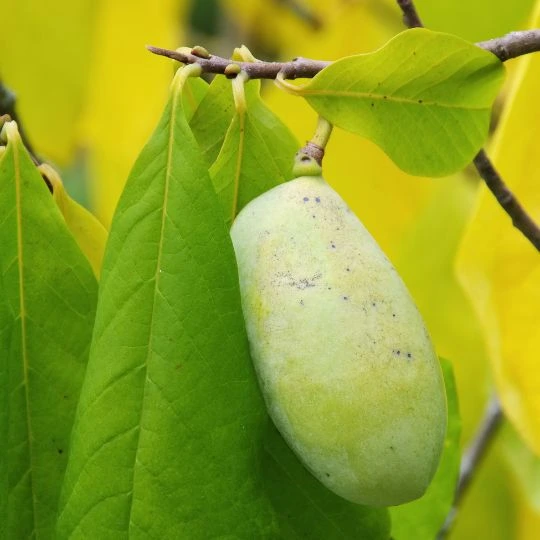
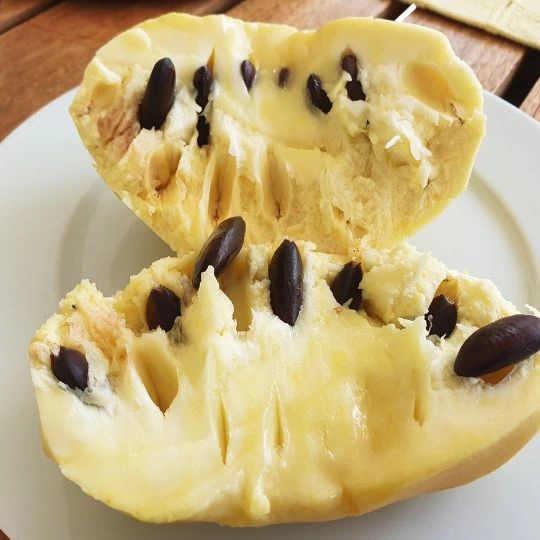
How to Care for Papaya Plants
Care/ Maintenance
Papayas are heavy feeders, so compost and mulch often to keep them well fed. Always ensure the mulch is pulled away from the trunk, as papaya stems are susceptible to rot.
Feeding
Feed monthly with compost tea, chop and drop mulch, worm juice, or organic fertiliser high in potassium.
Watering
Water deeply but allow the soil to dry slightly between waterings.
Harvesting
- Fruit takes 5–8 months to mature from a flower.
- Harvest when the skin starts to turn yellow.
- Clip off with secateurs. Ripen further indoors.
- Use green if preferred for savoury dishes (salads, curries, stir-fries).
Can you Prune Papaya Plants?
Yes! Some Papaya plants can get very tall, which is great for shade, and as the canopy is overhead, they take up less room in the garden. However, this can make it very hard to pick ripe fruit. Pinching the top of the Papaya plant can force it to stop growing taller and branch out. If your papaya does get too tall, you can cut the main stem, which will also force it to branch out. Stems can be hollow, so you may need to cover the cut to stop rain from getting down in the stem and causing rot. An upside-down container can work well. Prune off the older yellowing leaves by gently pulling down on the stem. This will help to divert energy back to the plant.
Pests / Disease
Slugs, slaters, and snails can also be damaging to young plants. Watch for fruit fly, root rot (in soggy soil), and mealybugs. Net fruit if needed. Birds, rats and fruit bats will also enjoy your fruit. It is best to pick fruit at the first sign of yellow and allow it to ripen inside to avoid attracting more pests.


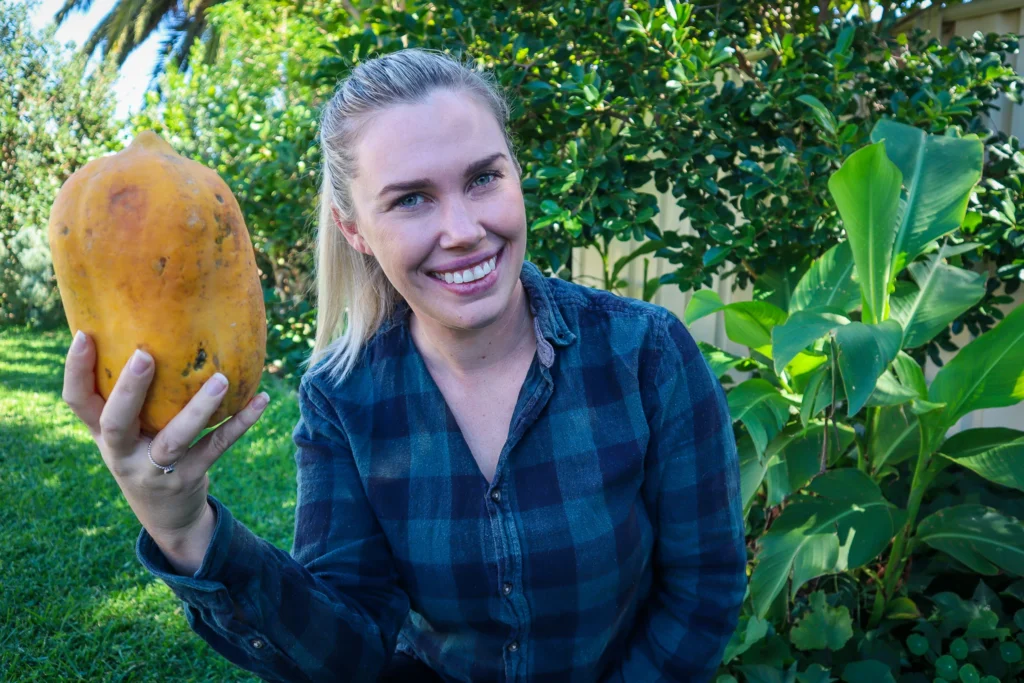
Reproducing Papaya
- Scoop seeds from ripe fruit.
- Rinse and dry thoroughly.
- Store in a paper envelope in a cool, dry spot.
- For better odds of getting bisexual plants, save seeds from bisexual fruits only.
Cooking and Using Papaya
Papaya is delicious raw or cooked as well as ripe or unripe. Making it a great staple food to grow in the garden.
Papaya pairs well with: seafood, strawberry, nuts, lemon, spinach, mint, mango, kiwifruit, cucumber, lime, coconut, mint, yoghurt, honey, ginger, turmeric
Papaya ideas:
- Salads
- Breakfast bowls
- Green Papaya salad
- Papaya Chilli Sauce
- Smoothies
- Jam
- Icecream
- Pickled
Preserving your Papaya Harvest
- Dehydrate slices for chewy papaya snacks
- Dehydrate into wraps for quick and easy lunch options
- Freeze chunks for smoothies or sorbet
- Ferment or pickle green papaya
- Dry seeds and grind as a peppery spice
